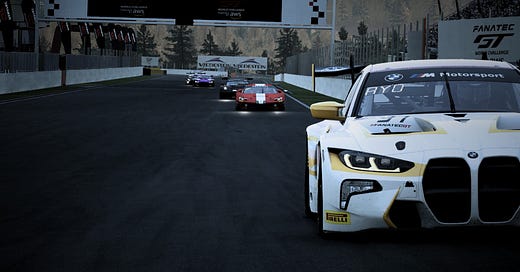Why are car setups so massively important in sim racing and racing overall? This is the most frequently asked question on my YouTube channel. Do you have a setup for the Audi on Brands Hatch? Does this work for GT4? What about the Porsche?
Many racers, including myself, are searching for a shortcut to find the perfect setup for the best performance. Sometimes we get lucky, but then it's just a specific car-track combination. The better the car setup for you, the less effort you need to put in to make your car behave as you like, allowing you to focus on improving your driving.
If we boil it all down to one thing, a setup is nothing more than a tunnel from input > setup > car behavior. You can focus all your effort on a car setup, but you can also change your input. A car setup will be constant, but your inputs can vary.
As you advance, you'll work on your input because setups can be limiting. I'm working on a video where I explain the different levels of it. It would be great if we came up with a system where you could unlock certain features to adjust as you gain more experience.
I've made a preset on the YouTube channel, and I'm going to try to explain how to proceed from beginner to semi-advanced and maybe later into achieving super-fast lap times.
If we take Spa as a benchmark and the Aston Martin V8 GT3, Eau Rouge and Raidillon Turn 2 and 3, you have to lift to not cut Turn 3 and invalidate the lap. This also counts for Blanchimont in Sector 3. This setup is safe when on the power, turning, or braking - the car will be safe.
When we are harsh on steering inputs, throttle, and braking abruptly, the car will be stable, and we can get away with bad inputs. This is okay and necessary to start out.
Now, if we keep our setup, we can improve lap times by getting better at braking, being more aware of turn-in points, and improving our timing with the throttle. But we need to pivot into a faster and more responsive car setup to improve and get faster.
"Responsive" means the front of the car will get more dominance over the rear.
Going back to Turn 2 and 3 on Spa, to not lift in this fast section, we need a car setup that allows the car to steer in the corner when going faster.
But there's a problem here. You will sacrifice safety in your car setup. Let's say we increase the rear ride height and allow the springs to have less travel on the rear (less bump stop range). We are creating a car that will have more weight on the front tires at higher speeds.
When we are harsh on our steering input at speeds of 200 kph+, we can spin. When we suddenly change direction, the car will quickly move in the direction where you're steering towards, but with the weight of the car moving in this direction as well, creating a bit of a run-up body roll effect of the car.
In other words, you need to use a more subtle, gentle input to steer the car into fast corners.
What does all this improve? We carry more speed into the corner, so we need to improve our input to get away with a less forgiving setup.
I think when a car setup has fast lap time potential, it also has a lot of error potential.
But why? You need your car to steer into certain corners with a lot of grip in the front so you can carry speed into corners. When we go on the throttle gently, we rotate the rear out of corners to get on the throttle more early, making us faster.
I'm going to introduce you to a new concept in sim racing: Front Grip Overhead!
How much front grip overhead can you get away with?
The most available grip on the front in the corner where you most need it, but don't need it in other corners. For example, when we need lots of front grip in Campus and Stavelot (Turn 14, 15, and 16), and we adjust the setup to fit our car there, we run into a problem in the Pouhon corner (Turn 12).
We are struggling with front grip overhead; we need that front grip in Turn 12, but as we're going a little downhill, braking and cornering, we may have way too much grip on the front. So, we need to be careful and sensible with our inputs to NOT use the full front grip of the car.
This is your skill input, and the biggest challenge is to find ways to optimize this. That's why we can have infinite car setups for different cars, driver skills, tracks, and I didn’t even speak about track conditions, fuel level, and tire wear.
What to take away from this: if you want to improve your lap times using a different setup, make the front have more grip. Lower the front ride height, increase bump stop range on the front, decrease brake bias, increase the rear ARB, decrease rear toe values, etc.
I'm not finished with this subject; I'm going to make videos on this topic, covering different levels of setups for different driver skills.



